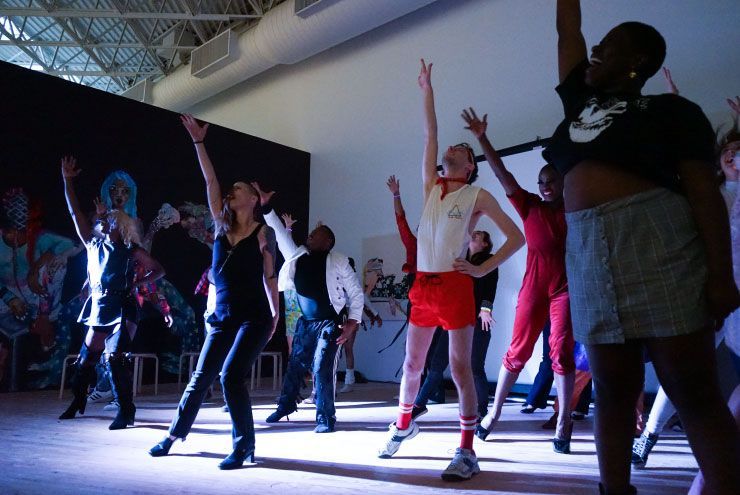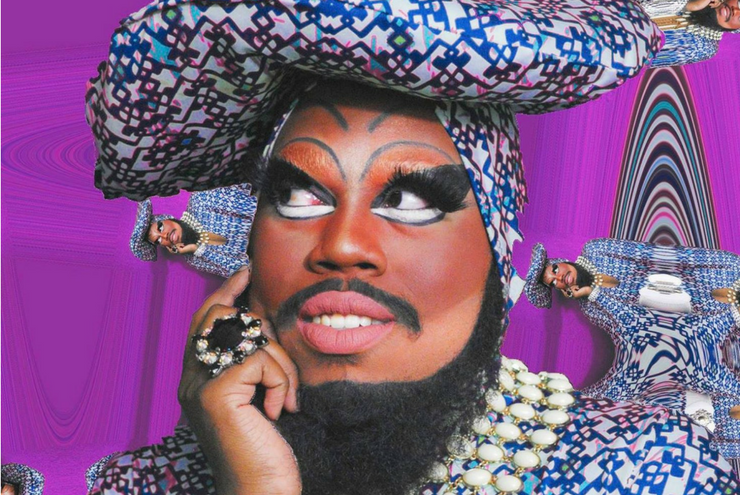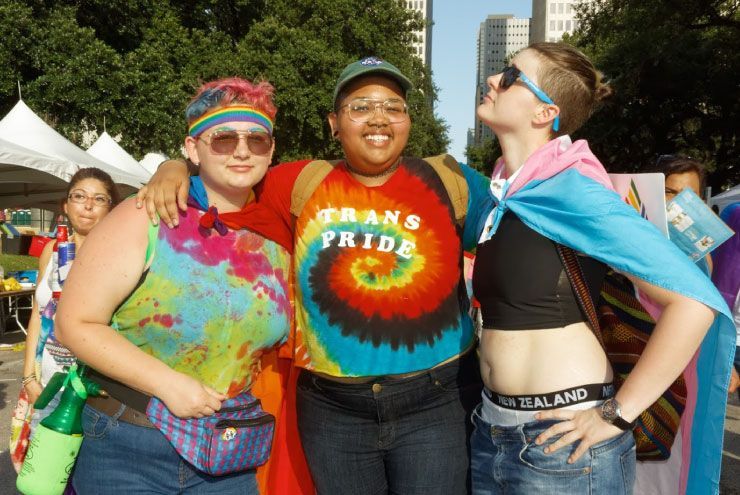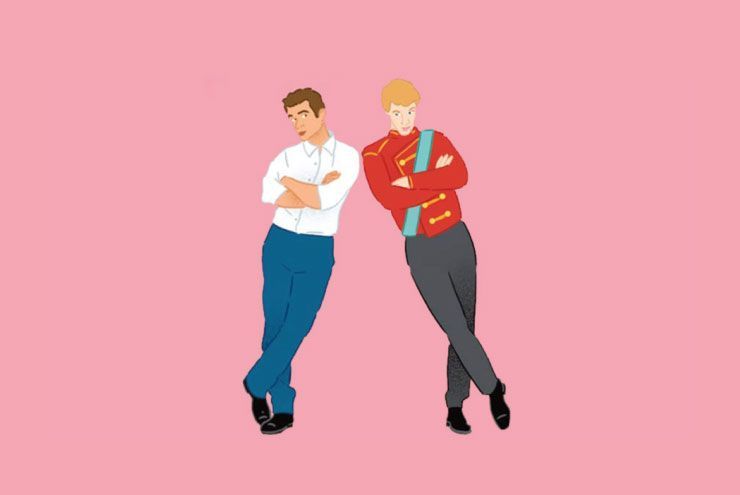By Addie Tsai
No pride for some of us without liberation for all of us.—Marsha P. Johnson
I was a radical, a revolutionist. I am still a revolutionist . . . I am glad I was in the Stonewall Riot. I remember when someone threw a Molotov cocktail. I thought, “My god, the revolution is here. The revolution is finally here!”—Sylvia Rivera
On May 30, 2019, a small group of performers and a few members of the Houston community who identify under the LGBTQIA+ umbrella took the stage at the Contemporary Arts Museum Houston (CAMH) to commemorate the 50th anniversary of the Stonewall uprising to a packed audience. Queer dancer and choreographer Rebecca French curated the performance, which was co-sponsored by CAMH and presented in conjunction with Stonewall 50, CAMH’s current exhibition featuring local, national, international, and multi-generational visual and mixed media works of art that address queer and trans identity and history.
But, what is the Stonewall uprising? According to The Atlantic’s Garance Franke-Ruta, the Stonewall uprising:
played out as six days between young gay, lesbian, and transgender individuals and the New York Police Department in the wake of a police raid of the Christopher Street Bar in Manhattan’s West Village. The raid came amid a broader police crackdown on gay bars for operating without NY State Liquor Authority licenses, which was something they did only because the SLA refused to grant bars that served gay [patron]s licenses, forcing them to operate as illegal saloons. Into that void stepped opportunists and Mafia affiliates, who ran the unlicensed establishments and reputedly had deals with the police to stay in business. But on the night of June 27, 1969, a police raid on the Stonewall involving the arrests of 13 people inside the bar met unexpected resistance when a crowd gathered and one of those arrested, a woman, cried out to the assembled bystanders as she was shoved into a paddy wagon, “Why don’t you guys do something!”
The conflict over the next six days played out as a very gay variant of a classic New York street rebellion. It would see: fire hoses turned on people in the street, thrown barricades, gay cheerleaders chanting bawdy variants of New York City schoolgirl songs, Rockette-style kick lines in front of the police, the throwing of a firebomb into the bar, a police officer throwing his gun at the cries of “occupy—take over, take over,” “Fag power,” “Liberate the bar!,” “We’re the pink panthers!,” smashed windows, uprooted parking meters, thrown pennies, frightened policemen, angry policemen, arrested Mafiosi, thrown cobblestones, thrown bottles, the singing of “We Shall Overcome” in camp fashion, and a drag queen hitting a police officer on the head with her purse.
As many historians and journalists have said, the Stonewall uprising provoked the gay revolution. It is the reason many metropolitan cities celebrate Pride during the month of June, and it is largely cited as the first major incident in which many LGBTQIA+ Americans began to fight back.
“What is the Stonewall uprising?” is perhaps an easier question to answer than “What does it mean to create dance and performances which commemorate the Stonewall uprising?” For the nine performers who took the stage at Up Rising: A Night of Dance Commemorating Stonewall’s 50th Anniversary, it appears that answer varied based on performer and, in some cases, choreographer.
The evening opened with the full cast strolling back and forth across the stage, Dusty Springfield’s “You Don’t Own Me” playing in the background, greeting one another with a kiss or an embrace, as if they were patrons of the Stonewall Inn. On the wall behind the stage and directly facing the audience rested pieces of artwork included in CAMH’s Stonewall 50 show. Part of me wishes that the show had been performed closer to the bar tops from Mary’s…Naturally!, the iconic gay bar that was formerly located in the heart of Montrose, Houston’s gayborhood. It would have been a fitting recognition of one of the most important gay businesses in Houston’s history, and also a bar that was the site of serial police raids in the late ‘70s and early ‘80s. Additionally, Mary’s was an important venue for queer fundraising in Houston, for AIDS and other community concerns.
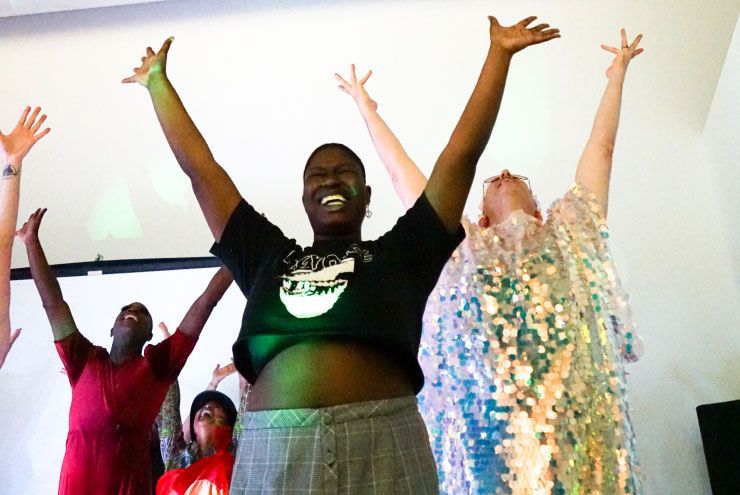
Performers at ‘Up Rising: A Night of Dance Commemorating Stonewall’s 50th Anniversary’ at the CAMH. Photo by Hannah Lange.
As the cast moved to their seats on both sides of the stage, a short slideshow depicting the history of Stonewall and queer resistance played on a standing projector screen in the center of the stage. The slideshow concluded with trans activist Marsha P. Johnson, one of the first instigators in the Stonewall uprising, reciting her poem, Soul, to an audience:
you can count your karma
if Nirvana is your goal
you can shake and you can rattle
you can rock and roll
you can be a Clark Kent
or a Lois
or an Alice down a hole,
you can be a vampire on a mountain
with a heart of stone black coal
you can be a leather angel
on a sleek black Harley bike
or a redhead screaming faggot
or a dazzling dyke
you can lock yourself in a closet
in a fine mink stole
but it really doesn’t matter
if you ain’t got soul
It was an apt opening for a show commemorating the Stonewall uprising’s 50th anniversary, given Johnson’s pioneering role during Stonewall and throughout her career and life.
Titled Tongues Still Untied, Black contemporary dancer Harrison Guy offered a moving homage to Marlon Riggs’ 1989 essay film, Tongues Untied, which gave voice to Black gay men, presenting their cultures and perspectives on the world as they confront racism, homophobia, and marginalization. The film, which blends poetry, music, performance, and Riggs’ autobiographical reflections, seeks to, in Riggs’ words, “shatter the nation’s brutalizing silence on matters of sexual and racial indifference.” Guy walked on to the stage dressed in a simple black top and black track pants, adorned with small black tassels, black shoes, and a white jacket. As excerpts from Riggs’ film played on the projector behind him, Guy performed frenetic, yet grounded movements. Many, while quieter in tone, evoked a kind of tribute to voguing, a dance style that was originally birthed from QPOC in the same New York City streets as the Stonewall uprising itself. Juxtaposed against the bodies in the film—performing similar movements of bent wrists and extended arms—Guy created a conversation between his body and those on screen, adding to the kind of dialogue that is still taking place between queer Black bodies then and now. The piece concluded on a powerful note, with Riggs’ speaking his own powerful truth as a queer Black man at the height of the AIDS epidemic thirty years ago: I was mute / tongue tied / burdened by shadows and silence / now I speak and my burden is lightened / lifted / free. White text was then projected onto Guy’s black shirt: “Loving is the revolutionary act.”
Gender-fluid dancer and choreographer jhon stronks performed their piece, ShimMe, in a loose-fitting dress covered in the same shimmering sequins that adorned the wrap tied around their head. Red stilettos and large, pink-tinted sunglasses completed the costume, a favorite outfit of stronks (one can see why, as the sequins make gorgeous light displays against plain surfaces). Tonight was no different—as stronks shimmied, arabesqued, strutted, swayed, and bounced up and down, the many little lights emitted from the fabric also danced against the floor and the walls behind them. In this vein, I would consider stronks a performer rather than a dancer, as there was little cohesion or fluidity connecting one movement to another, and there seemed to be little impetus for the movement itself outside of body and light play. The movement was cast against the musical artistry of many Black artists, such as Sade, Roberta Flack, and ANT. Although I appreciate their elevation of Black artists, I have concerns about the privilege embedded in a piece of this nature, in which Black identity—identity that has been painstakingly crafted and honed in a world in which Black lives fight to be heard and seen—is presented against a backdrop of white-centered movement that can be seen as a kind of afterthought in contrast. Overall however, stronks is a true advocate for Black voices, both on and off the stage, and I look forward to seeing how these ideas can culminate in a more externalized manner.
Performers Ayan Felix and Kate Rash entered the stage in jumpers, which they quickly stripped down to reveal white unitards (with yellow smiley face stickers affixed to where one might imagine their nipples to be) and white street sneakers. Set to an original composition by Black queer music artist DJ HYPERFEMME, Felix and Rash writhed on the floor, sometimes alone, but most interestingly, thrashing against each other. Every so often, one or the other would yell, “Ouch!,” and would then wriggle around, trying to find a better fit between their two bodies. I found this contemporary dance performance to be a delicate and fascinating exploration of queer femme intimacy, one that seemed to also physically embody the negotiation of queer sexual intimacy, consent, and comfort (or the lack thereof) as two bodies find ways to coalesce with one another. As one could clearly see Felix’s Black body set against Rash’s white form, I found myself wondering how differently this piece would tackle those same embodied questions if two Black bodies, perhaps even of varying sizes and proportions, were present on stage—what kind of images and patterns could emerge from this exploration? It would be exciting if, in another version of this piece, the audience could see Felix play more with what it means for a Black and a white body to attempt to merge together in a more explicit conversation around privilege, agency, and intimacy.
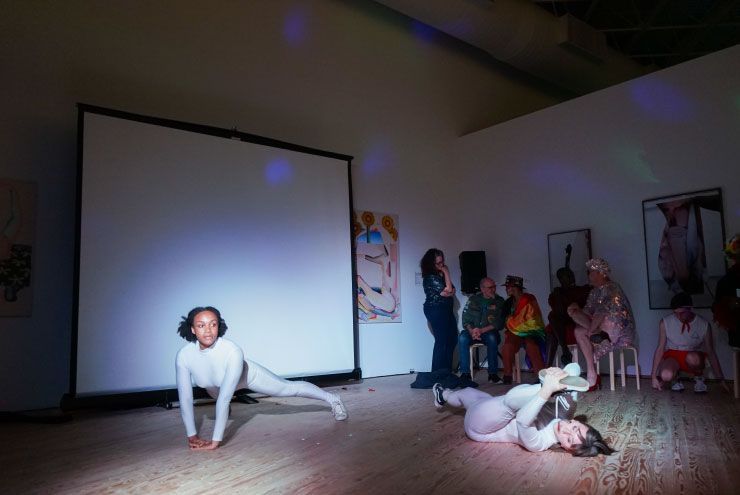
Performers Ayan Felix (l) and Kate Rash. Photo by Hannah Lange.
Stoo, a Black non–binary performer and musical artist, entered the stage dressed in a black leather dress and thigh–high suede boots. Their performance of lip sync and live vocalizations to their original composition, “Abracadabra,” was electric and brought energy to both the cast and the audience. Stoo’s movements were sensual and joyous, offering a refreshing non–binary depiction of sexuality and style, and the performance was an overall moving musical number on self-actualization.
Rhythm tap artist Kirstin Grbic sat on a small stool; in front of her, a small synthesizer and white toy piano rested on the end of a metallic trunk. On the other end, Ty Moore sat on the trunk itself, wearing black bottoms, a red lace top, and elegant white heels. Grbic was dressed more subtly, with a white shirt, jeans, a gray-and-red plaid blazer, and white Oxford-style tap shoes. Before they began, the two reached over the piano and gave each other a greeting kiss. The energy that emitted from the pair’s loving friendship was witnessed throughout, giving the entire piece a feeling that this performance could have happened anywhere. I personally imagined it taking place in an art studio past the midnight hour, or even in a bar not unlike the Stonewall Inn. As Grbic played a series of composed beats on a small synthesizer interchangeably with a few notes on the toy piano, Moore vocalized a raw, genuine rendition of Active Child’s “These Arms.” In the middle of the performance, they giggled with one another, which provided a sweet pause for the audience to witness. The duo offered a moment of queer authenticity when Moore encouraged the audience and the cast to clap a beat along to the music. Grbic then took to the floor to riff a few improvisational bars of rhythm tap, bringing to mind the long queer and resistive history of tap as a Black-birthed art form. Given both the Irish and Black (and dominantly male) origins of rhythm tap in America, I found the visual of Grbic’s white femme body next to Moore’s Black gender fluidity to be a welcome duet of the history of rhythm tap itself. The duet reached its peak when Moore and Grbic performed a kind of call and response, where Grbic ferociously tapped in response to Moore’s vulnerable a capella of a few bars of “Somewhere Over the Rainbow,” a sweet, subtle nod to the long-held theory that Judy Garland’s funeral, which was held on the first night of the Stonewall uprising, provoked some members of the community to fight back in her honor. It was this tethered conversation between Moore and Grbic, in voice and body, song and drumming foot, that I yearned to see more of.
The drag performer Olly Oxen—maneuvering a lit-up fabric pair of wings and dressed in a black top that exposed her midriff, boots, camouflage sweats, and glow-in-the-dark makeup—grooved, thrusted, and grinded in the air and on the floor to various club remixes, such as those by the Scissor Sisters and Basement Jaxx, and aptly ended with Electric Six’s “Gay Bar.” Oxen’s performance provided a queer club-like atmosphere, complete with glow sticks for the audience and glow-in-the-dark handprints on each butt cheek. Her movement was feisty and sexy, bringing a kind of queer levity to the evening.
Donald Shorter’s powerful lip–sync to an excerpt from trans activist Sylvia Rivera’s speech “Ya’ll Better Quiet Down,” at the 1973 Christopher Street Liberation Day Rally in New York City, was a powerful, sober moment to end the evening, returning the show back to its intention, to celebrate the 50th anniversary of the Stonewall uprising. Shorter’s performance to a recording of the original speech was fiery and poignant, and his performance was clearly an intricate embodiment of Rivera’s speech and activist affect. Dressed in a red one–piece with ruffled shoulders, thick black eyelash extensions, and red lipstick, Shorter’s Black femme presentation was equally formidable against the revolutionary words of Rivera. I appreciated the framing of the show—beginning the evening with Marsha P. Johnson and ending with an homage to Sylvia Rivera, as it gave the audience a true depiction of the voices of Stonewall.
The entire show concluded, after a slideshow depicting America’s LGBTQIA+ history, with a full cast performance of a synchronized dance to George Michael’s “Freedom.” While I wished the show could have ended on Shorter’s incendiary embodiment of Rivera’s words (rather than with a white European musician’s song), overall, Up Rising: A Night of Dance Commemorating Stonewall’s 50th Anniversary was an electric and necessary showcasing of queer performance, and I was thrilled to see so much of Houston show up for this rare event. It is my hope that what was started during this evening will be extended through more performances that tackle not only the Stonewall uprising, but also what rights are at stake for LGBTQIA+ Americans in 2019—performances that center the trans experience, and critique the violence that the trans community, particularly trans women of color, continues to face day to day.


